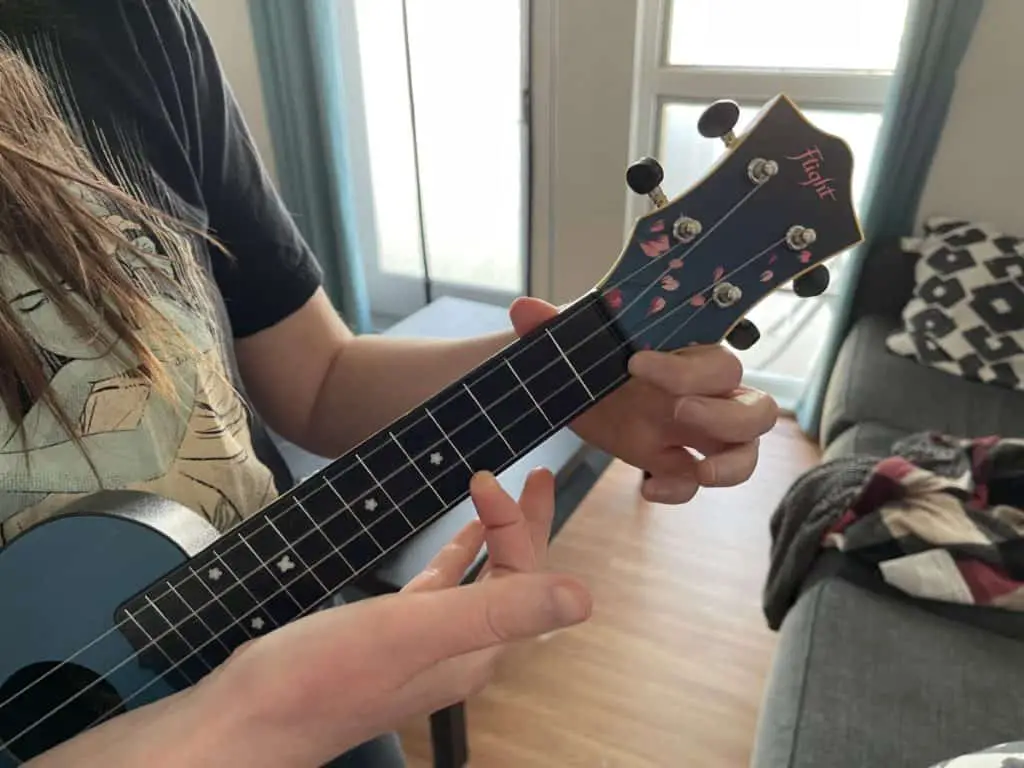Today I’m going to break down (pun intended) how long it takes to break in new ukulele strings and how you can speed the process up!
I still remember the frustration I felt when I got my first ukulele and the darn thing wouldn’t stay in tune.
Breaking in ukulele strings can be a real pain! But it doesn’t have to be. There are a few cool tricks to get you through the worst part quicker and some even let you have fun while doing it!
Let’s get started!
How Long it Takes to Break In / Settle Ukulele Strings
It can take 2 days to 3 weeks to break in new ukulele strings depending on their composition. Nylon takes the longest to break in, nylgut takes a little less time, and fluorocarbon and titanium take very little time. You can accelerate the process with stretching, by practicing bends, or by tuning up a half step.

Nylon Ukulele Strings Break-In Time
Many ukuleles are strung with nylon strings, which are popular for their warm and relaxing tone and comfortable feel.
Nylon is a thermoplastic polymer with silk-like properties. And just like the silk it emulates it is very stretchy.
Of all ukulele strings, nylon is the most elastic and therefore takes the longest to break in. It is also the most sensitive to temperature changes.
Brand new nylon strings will stretch themselves out of tune quickly and will require frequent retuning to hold their pitches and “bed in.” This process can be so disheartening that many beginner players return their instruments thinking they are defective!
The good news is that once bedded in nylons will only require slight adjustments to hold their tune.
Nylon strings require a break-in period of around 48 hours of active playing. Most players estimate that this comes out to about 3 weeks of playing at least a half hour each day. This long timeframe can definitely be frustrating!
Luckily, there are a few tricks that speed this process up! Keep reading to learn more.
Nylgut Ukulele Strings Break-In Time
If you buy a lower to mid-range factory-produced ukulele, odds are it comes strung with some form of nylgut strings. These strings simulate the warm, pleasant sound of old-fashioned gut strings and are white in color.
Compared to nylon, nylguts have less elasticity and therefore have a much shorter break-in period. They still have some stretch, though, so don’t expect them to sound their best right away!
Nylgut strings have a break-in period of about 3 days. After about a week of regular playing, they will be relatively good at holding their tune. They are also much less sensitive to temperature swings!
Fluorocarbon Ukulele Strings Break-In Time
Fluorocarbon strings are becoming more popular and are especially desirable for players who fingerpick. They have a bright, lively tone but may not be as comfortable on the fingers as they are thinner in diameter and carry more tension.
Fluorocarbon is essentially fishing line. As you’d expect, it is much less elastic than nylon and nylgut and is also more durable – which makes sense because otherwise the fish would always get away!
Of all the ukulele strings fluorocarbons settle in the quickest. After just 2 to 3 days of regular playing and retuning, the strings reliably stay in tune and stay that way for the rest of their lives.
As a bonus, fluorocarbons are also relatively unaffected by temperature swings and last a long time compared to other string materials.
Titanium Ukulele Strings Break-In Time
Titanium strings are relatively new on the ukulele scene but have quickly developed a devoted following due to their bright sound, durability, increased volume, and snazzy purple color.
Despite their name, titanium strings are not hard or metallic. They are composed of a monofilament of titanium fibers and feel more like nylon than fluorocarbons. But unlike nylon, titanium strings have relatively little give and therefore break-in much faster.
Titanium strings are the best of both worlds. The bedding in timeframe is similar to that of fluorocarbons and takes about 2 to 3 days of playing and retuning.
How to Break-in Ukulele Strings Quickly (3 Tips)
Waiting for ukulele strings to bed in on their own can be frustrating, especially when all you want to do is enjoy playing your uke!
Luckily, there are some ways to safely speed up the process! Let’s take a look at 3 tips to get you back to playing faster:
Tip 1: Use a Stretching Routine
New ukuleles often sit for months or years in a warehouse before finally making it into your loving arms.
In many cases, strings are put on as fast as possible and kept at lower tension which means the knots are probably loose. A brand new uke is always in need of some TLC right out of the box!
Rather than wait for ukulele strings to bed in naturally, you can accelerate the process by physically stretching them.
You can use this routine for new ukuleles, after restringing, and anytime your instrument has sat unplayed for a length of time.
I’ll walk you through the process
1. First, tune your ukulele.
Don’t worry about fine-tuning at this stage, just get it roughly in tune.

2. Place the palm of your hand on the bridge of your ukulele.
Then stick your finger underneath one of the strings above the sound hole. Gently pull the string straight up (away from the body) about one half of an inch. Never pull too hard or too far up as this could snap the string!

Holding your palm on the bridge protects it from undue stress and keeps all the tension on the string, which we are trying to stretch. This move will also tighten the knot holding the string to the bridge, which will help your uke stay in tune.
3. Repeat Step 2 for each of the four strings.
4. Now, use a finger on your fretting hand to hold the string against the nut.
The nut is the thin strip of material that holds the strings where the neck joins the headstock. Lay your forearm against the body of the uke and use your strumming hand to pull up on the string closer to the nut.
We are essentially repeating step 2 to snug up the slack on the tuning pegs.

Holding your finger against the nut and your forearm against the body keeps all the tension on the string and protects the neck and body from stress.
5. Repeat step 4 for each of the four strings.
6. Tune your ukulele again.
You’ll notice it’s probably very out of tune. This is good! This means the strings have stretched7. Play your ukulele!
I like to do a few chord changes with heavier strums to move the strings around a little bit kind of like a workout. You will probably hear your uke go out of tune after a few minutes of play.
8. Repeat steps 1 through 7.
This may take many rounds, especially for nylon strings. But your ukulele will be less out of tune each time and by the end will hold its tuning!
Watch this video of Sam Marchuk using a stretching routine on a new ukulele to see these steps in action.
Tip 2: Play and Retune A LOT.
If you don’t want to do a stretching routine, just keep playing and retuning! The more hours you log, the faster the strings will break in.

Take this time to practice your bends, as this side-to-side movement stretches the strings naturally.
Tip 3: Tune Your Ukulele Up a Half Step
Tune each string sharp. So, for the A string, tune it to A sharp and so on. This adds a little extra tension to the strings and stretches them without you having to do so much work.
You can either play tuned sharp or let the uke sit. This works great if you are pressed for time as it can stretch overnight or when you are done playing.
Some professionals even do this with newly strung ukes before concerts so their ukulele drifts slowly into tune rather than out of tune as the strings stretch!
Do Ukulele Strings Actually Need to Settle?
All ukulele strings need to settle in to sound their best and hold their tuning. The strings will have to adjust to the new tension put upon them and the knots holding them at each end will have to tighten up. This either takes time or effort to resolve.